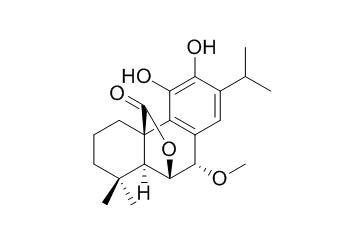7-O-Methylrosmanol
7-O-methylrosmanol can effectively suppress FSK-induced luciferase expression under the control of the CRE, PEPCK-C and G6Pase gene promoters, it may contribute to its antihyperglycemic activity.
Inquire / Order:
manager@chemfaces.com
Technical Inquiries:
service@chemfaces.com
Tel:
+86-27-84237783
Fax:
+86-27-84254680
Address:
1 Building, No. 83, CheCheng Rd., Wuhan Economic and Technological Development Zone, Wuhan, Hubei 430056, PRC
Providing storage is as stated on the product vial and the vial is kept tightly sealed, the product can be stored for up to
24 months(2-8C).
Wherever possible, you should prepare and use solutions on the same day. However, if you need to make up stock solutions in advance, we recommend that you store the solution as aliquots in tightly sealed vials at -20C. Generally, these will be useable for up to two weeks. Before use, and prior to opening the vial we recommend that you allow your product to equilibrate to room temperature for at least 1 hour.
Need more advice on solubility, usage and handling? Please email to: service@chemfaces.com
The packaging of the product may have turned upside down during transportation, resulting in the natural compounds adhering to the neck or cap of the vial. take the vial out of its packaging and gently shake to let the compounds fall to the bottom of the vial. for liquid products, centrifuge at 200-500 RPM to gather the liquid at the bottom of the vial. try to avoid loss or contamination during handling.
Journal of Third Military Medical University2019, 41(2):110-115
Regen Biomater.2023, 10:rbad077.
Aquaculture2017, 481:94-102
Foods.2023, 12(6):1227.
Chemistry of Plant Materials.2016, 33-46
Mal J Med Health Sci.2024, 20(SUPP5):151-156.
Food Science&Tech. Res.2022, 28(2):123-132.
Pharmaceutics.2021, 13(7):1028.
J Physiol Biochem.2024, 80(2):421-437.
BMC Plant Biol.2018, 18(1):122
Related and Featured Products
J Nat Prod. 1993 Aug;56(8):1426-30.
Inhibitory effect of carnosic acid on HIV-1 protease in cell-free assays.[Pubmed:
8229021]
METHODS AND RESULTS:
In order to find new effective HIV protease inhibitors, two diterpenes (carnosic acid [1] and carnosol [5]) were isolated from rosemary (Rosmarinus officinalis L.), and rosmanol [2] and semisynthetic derivatives (7-O-Methylrosmanol [3], 7-O-ethylrosmanol [4], and 11,12-O,O-dimethylcarnosol [6]) were prepared. The inhibitory activity of all six compounds against HIV-1 protease was tested. The carnosic acid [1] showed the strongest inhibitory effect (IC90 = 0.08 micrograms/ml). The same compound was also assayed against HIV-1 virus replication (IC90 = 0.32 micrograms/ml).
CONCLUSIONS:
The cytotoxic TC90 on H9 lymphocytes was 0.36 micrograms/ml, which is very close to the effective antiviral dose. Additionally, the tested compounds did not inhibit cellular aspartic proteases cathepsin D and pepsin at the concentration range up to 10 micrograms/ml.
Phytother Res. 2013 Jun;27(6):906-10.
Phenolic diterpenes from rosemary suppress cAMP responsiveness of gluconeogenic gene promoters.[Pubmed:
22927089]
The cAMP/protein kinase A/cAMP response element (CRE)-binding protein pathway is important for various physiological aspects including regulation of gluconeogenic gene expression. Rosemary, a well-known herb, has been reported to decrease blood glucose levels.
METHODS AND RESULTS:
We found that methanol extracts of rosemary suppressed forskolin (FSK)-stimulated luciferase expression under the control of CRE, as well as the promoters for cytosolic phosphoenolpyruvate carboxykinase (PEPCK-C) and glucose-6-phosphatase (G6Pase) catalytic subunit genes in human hepatoma HepG2 cells. Three abietane-type diterpenes and two flavonoids were isolated from the rosemary extracts. Among these, 7-O-Methylrosmanol (1) and royleanonic acid (3) effectively suppressed FSK-induced luciferase expression under the control of the CRE, PEPCK-C and G6Pase gene promoters. PEPCK-C and G6Pase, which play a key role in the homeostatic regulation of blood glucose levels, are important for managing type II diabetes mellitus.
CONCLUSIONS:
Therefore, the ability of rosemary and its components to suppress cAMP responsiveness of the PEPCK-C or G6Pase gene may contribute to its antihyperglycemic activity.
J Nat Prod. 2009 Aug;72(8):1385-9.
Semisynthesis and biological evaluation of abietane-type diterpenes. Revision of the structure of rosmaquinone.[Pubmed:
19711987 ]
METHODS AND RESULTS:
The new aromatic diterpenes 7beta-O-benzylrosmanol (3), 7beta-O-benzyl-11,12-di-O-methylrosmanol (4), and 7alpha-thiophenylcarnosic acid (5) have been obtained by partial synthesis from carnosol (1), an abundant natural diterpene present in Salvia species. The structures of these compounds were established from their physical and spectroscopic data. The known diterpenes sagequinone methide A (6), 7beta-O-methylrosmanol (7), 7-O-Methylrosmanol (8), and rosmaquinone B (9) were obtained from rosmanol (2). The spectroscopic data of these semisynthetic diterpenes were identical to data reported in the literature. In addition, the new semisynthetic isorosmaquinone (10) was obtained from isorosmanol (12).
CONCLUSIONS:
The proton resonances of rosmaquinone (11) are reassigned based on 2D NMR spectroscopy. These compounds, as well as eight known analogues, were evaluated for cytotoxic and antimicrobial activities.



